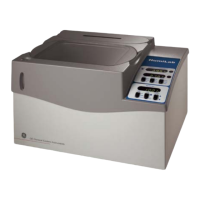Appendix B — Humilab chilled mirror hygrometer details Page 61
Helpful hints
This Section contains background information that will help you
better understand the Humilab’s chilled mirror hygrometer system
operation and its use in the Humilab.
Time response
At dew points above 0°C, the system stabilizes within a few seconds
on the correct dew or frost layer. Take dew/frost point readings
only after the green control light has come on.
Time response depends on a number of factors: slew rate, dew
point, etc. Slew rate is in turn dependent on dew point and depres-
sion; at higher dew points and moderate depressions, it is typically
1.5°C/second. At lower dew points and/or larger depressions (the
temperature difference between the mirror and the sensor body),
slew rate becomes progressively slower.
Flow rate affects response by determining the rate at which water
vapor is supplied or carried off. There is, of course, a trade-off
between response time, control system stability, and sensitivity to
contamination. Install the sensor cover in the “open” position for
proper response time. That is, the large holes in the cover allows
maximum air sample into the sensor cavity.
Mirror
cleanliness
Proper operation of a condensation hygrometer depends on the
condition of the mirror surface. In general, accuracy is reduced
when contaminants accumulate on the mirror.
However, the mirror does not have to be microscopically clean. In
fact, the mirror performs best a few hours after cleaning. On an
unscratched, freshly cleaned mirror, there are relatively few nucle-
ation sites on which dew or frost deposits can form, so it takes
longer to collect a condensate layer at low frost points. Also, over-
shoot occurs, which can cause oscillation.
Particulate contaminants.
Particulate matter that is insoluble in
water may accumulate on the mirror surface, but usually does not
affect the instrument accuracy until the mirror reflectance is
reduced substantially. In many cases, particulates improve instru-
ment response by providing condensation sites.

